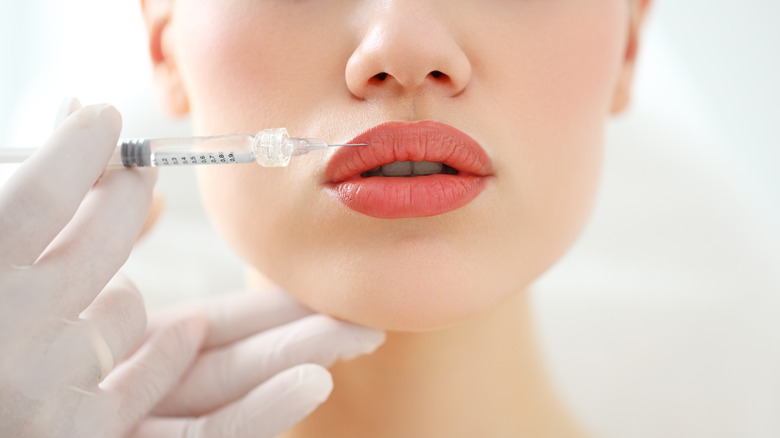Are There Ways To Avoid The Risks Of Filler Fatigue?
Fillers of all types are growing in popularity, becoming a quick way to fix minor imperfections such as wrinkles and bags underneath the eyes. Fillers are also commonly used to plump up lips and cheeks, making them a favorite among celebrities everywhere. While these are common in the beauty world, do you know that undergoing too many filler injections can have some potentially severe consequences? Experts are educating filler lovers on a side effect known as "filler fatigue" and its long-term impacts.
A fairly new term, filler fatigue is described by Manhattan oculofacial plastic surgeon Dr. Robert Schwarcz as overapplying filler into the face. He told Coveteur that doing so would result in "not all filler being fully metabolized." This can cause swelling and water becoming trapped in the face, leading to undesired puffiness. While this phenomenon still needs to be studied, Schwarcz says the proof is in patients who have received fillers a number of times in the same spot. So how can this be avoided? Well, there are a few things the patient should keep in mind.
Small amounts of filler can reduce the chances of filler fatigue
Having smaller portions of filler applied to an area can prevent much filler fatigue and the need for reconstruction down the line. A skilled injector will know to use it sparingly, even if the patient is urging them to do otherwise. According to the Victorian Cosmetic Institute, many patients see good results when only a few milliliters of dermal filler are injected. However, this is dependent upon the area needing the treatment. Board-certified plastic surgeon Dr. George Bitar backs this, explaining that the provider should know that a little goes a long way.
"Filler should look subtle, not like a patient's face has been plumped. Natural contours of the face should still be visible," Bitar told Huda Beauty. For this reason, he suggests examining before and after photos of an injector's work. If the results look too obvious, eager customers will want to look elsewhere, as this is a sign that they inject too much filler into one area. New York plastic surgeon Lara Devgan agrees, telling Allure that the bulk of filler fatigue falls on the injector for having a "lack of aesthetic judgment."
Do not get fillers touched up too soon
The time frame in which fillers last can vary depending on what area they are in. Lips may need touching up every three to six months, while the nose crevices could last anywhere from six to 12 months. No matter which area you've chosen to inject, spacing your filler appointments as long as possible helps avoid filler fatigue. Suppose you feel the need to retouch before your next session. In that case, Nicole Frontera, founder of Nicole Frontera Beauty, suggests trying a different remedy or "combination treatments," as she told Coveteur. If you got cheek fillers 10 months ago but still see a few wrinkles, try combining your fillers with laser resurfacing. According to Mayo Clinic, this procedure triggers collagen production, which drastically improves skin texture.
Some people can become addicted to fillers. Not necessarily to the needle pinch, but to the way they feel afterward. Having this minimally invasive treatment done can be a great confidence booster, but take it easy. If you are getting facial fillers while in your 20s, keep in mind that while injections can be preventative maintenance, your face will undergo natural changes as you get older, so refrain from going overboard. Remember, sometimes less is more; if your injector recommends going small, you should take their advice. If your filler fatigue is too extensive and you're considering having them removed, speak with a licensed professional to know everything you should consider before getting filler dissolved.

